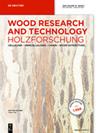Kraft pulping of model wood chips: local impact of process conditions on hardwood delignification and xylan retention
IF 1.6
3区 农林科学
Q2 FORESTRY
引用次数: 0
Abstract
Local evolution of delignification and xylan removal inside wood chips was investigated throughout the initial stages of kraft cooking. Model chips of birch sapwood were pulped at 145, 155 and 165 °C, utilizing white liquors with hydroxide content ranging from 0.25 to 0.55 mol/kg. The composition of different sections in each cooked sample was then determined. Xylan was isolated from selected samples and analyzed using size exclusion chromatography and HSQC NMR. Most changes in concentration and structure of residual xylan occurred early in the process (<45 min). Furthermore, xylan samples isolated from the tissue of different cooked chips had similar average molecular weights, indicating that temperature and alkali content had little impact over the extent of reactions affecting residual xylan. In contrast, xylan dissolution was significantly dependent on pulping conditions, increasing with hydroxide concentration. The lignin profile inside the cooked chips also varied with alkali content and temperature, and it was shown to be more uniform when applying low cooking temperatures (145 °C). Finally, increased delignification and xylan removal were detected close to the transverse surfaces of chips (likely due to the fast mass transport in vessels/lumen), implying that anatomical features of wood can have a significant impact on pulping.模型木片的牛皮纸制浆:工艺条件对硬木脱木素和木聚糖保留的局部影响
在牛皮纸蒸煮的整个初始阶段,研究了木片内部脱木素和木聚糖的局部演变过程。利用氢氧化物含量为 0.25 至 0.55 摩尔/千克的白液,在 145、155 和 165 °C 下对桦木边材的模型木片进行打浆。然后测定每个熟制样品中不同部分的成分。从选定的样品中分离出木聚糖,并使用尺寸排阻色谱法和 HSQC NMR 进行分析。残留木聚糖浓度和结构的大部分变化发生在加工过程的早期(45 分钟)。此外,从不同熟片组织中分离出的木聚糖样品具有相似的平均分子量,这表明温度和碱含量对影响残留木聚糖的反应程度影响不大。相反,木聚糖的溶解与制浆条件有很大关系,随着氢氧化物浓度的增加而增加。蒸煮木片内部的木质素分布也随碱含量和温度的变化而变化,在低蒸煮温度(145 °C)下,木质素分布更为均匀。最后,在靠近木片横向表面的地方检测到木质素脱除和木聚糖脱除增加(可能是由于容器/内腔中的快速质量传输),这意味着木材的解剖特征会对制浆产生重大影响。
本文章由计算机程序翻译,如有差异,请以英文原文为准。
求助全文
约1分钟内获得全文
求助全文
来源期刊

Holzforschung
工程技术-材料科学:纸与木材
CiteScore
4.60
自引率
4.20%
发文量
83
审稿时长
3.3 months
期刊介绍:
Holzforschung is an international scholarly journal that publishes cutting-edge research on the biology, chemistry, physics and technology of wood and wood components. High quality papers about biotechnology and tree genetics are also welcome. Rated year after year as one of the top scientific journals in the category of Pulp and Paper (ISI Journal Citation Index), Holzforschung represents innovative, high quality basic and applied research. The German title reflects the journal''s origins in a long scientific tradition, but all articles are published in English to stimulate and promote cooperation between experts all over the world. Ahead-of-print publishing ensures fastest possible knowledge transfer.
 求助内容:
求助内容: 应助结果提醒方式:
应助结果提醒方式:


